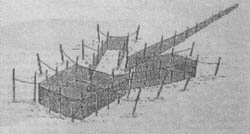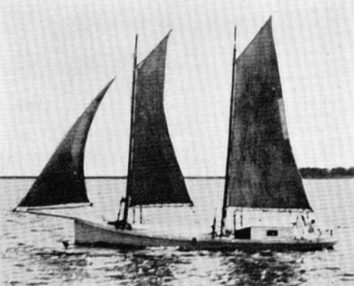
A shad boat at Wanchese, N.C., ca. 1938. Photograph by Charles A. Farrell. Courtesy, State Archives of North Carolina.
This is the 2nd part of my special series “The Story of Shad Boats.” The series features Earl Willis, Jr. and Mike Alford’s extraordinary journey to document the history of North Carolina’s “state boat.”
In the photograph above, we see a fisherman and his boat on the edge of a salt marsh at Wanchese, N.C., circa 1938. The village of Wanchese occupies a hammock on the south end of Roanoke Island, a broad, heavily wooded island between the Outer Banks and the mainland of Dare County.
Roanoke Island is best known for having been the site of the first attempt at English colonization in the Americas, but the site of the village is far more ancient. According to archaeologists, fishing peoples have inhabited the hammock where Wanchese is for 1,500 years or longer.
In the distance, we can see the home of the Tilletts, one of the village’s oldest fishing families. On a blustery winter day, a fisherman, perhaps one of the Tilletts, prepares to haul the boat onto Roanoke Sound.

View of Roanoke Island in relation to the Outer Banks and the mainland of NE N.C. Source: ESRI, ArcGIS Online
The boat is what I want to discuss today. It is a “shad boat,” a unique kind of round-bottomed wooden workboat that was only built in and around Roanoke Island in the late 1800s and early 1900s—and it is a unique window into a time, a place and a people.
I could not have described a shad boat properly without Earl and Mike’s research. But thanks to their study of the last surviving shad boats and their conversations with the last generation of shad boat builders, this is how I would do so in a general way now:
As you can see in the photograph, the boat is sleek and has gracefully curved frames—boat builders would say it is “round-bilged.” It is built out of local juniper (also known as white cedar), except for a centerboard that is probably oak but was sometimes pine.
The bow is straight, slightly raked with a bit of flare and the sheer is strong. The rudder hangs on a sternpost outboard that is part of a heart-shaped transom (the flat part that forms a square-ended boat’s stern). The boat’s beam (its widest point) is just forward of midships.
Like all shad boats, this boat is carvel-built. (See diagram below.) Copper-cut nails fasten the boat’s planks to root knee frames, and the builder hewed the boat’s keel, or “bottom piece,” out of a single log.

A comparison of clinker and carvel-built. Courtesy, Willhig at English Wikipedia
Also like all shad boats, this one is open (i.e., un-decked), except for the washboards, and is shallow draft, which makes it well suited to the shoal waters that surround Roanoke Island.
This and all shad boats were a relatively small workboats: as Earl and Mike’s research has shown, they typically ranged from 22 to 28 feet in length. However, for reasons I will discuss later, a large percentage of shad boats were 24 feet or very close to 24 feet from stem to stern.
Until the early 1900s, shad boats were all sailboats. In those days, they carried a spritsail rig with a highly distinctive topsail that local fishermen and boat builders called a “goose wing.”
Local builders designed the boats for a variety of uses—I have heard them referred to as the pick-up trucks of their day.
However, they gained the name “shad boat” because of their importance in the commercial fishery for shad (Aloso sapidissima), a common species of fish on that part of the North Carolina coast.

The American shad (Aloso sapidissima). Courtesy, U.S. Fish & Wildlife Service
“A shaggy, frontier town”
For half a century after the Civil War, the shad fishery was the largest and most important fishing industry on Roanoke Island, in the villages along nearby parts of the Outer Banks and in the fishing villages just to the west, on the mainland of Dare County.
Beginning in late winter and running into spring, great schools of shad left the Atlantic and migrated into the state’s sounds in order to reach their spawning grounds in the rivers and creeks that flowed into those sounds.
In the vicinity of Roanoke Island, fishermen harvested shad mainly in pound nets and gill nets, though a few gangs of fishermen also used haul seines.

Typical pound net. Courtesy, FAO of the United Nations

Typical set gill net. Courtesy, FAO of the United Nations
According to Alvah H. Ward and R. Wayne Gray’s splendid book, When Ice Came to the Outer Banks, the booming shad fishery after the Civil War “turned Wanchese into a shaggy frontier town.”
Later, after the island’s first ice house was built in Skyco, north of Wanchese, that village came to be called “the shad fish capital of the world.”
Fish businesses, net shops, sail lofts and ice houses sprang up.
Often shad fishermen crowded into fish camps built on pilings over remote salt marsh creeks. They weren’t fancy: bunkbeds, a pot belly stove and not much else. The men had their hands full during the season and could not afford to take the time to go home every night.

Fishermen and pound net stakes at the Baum Slough Fish Camp, Roanoke Island ca. 1905. Photo by H. H. Brimley. Provided by Earl Willis, Jr.
During the shad season, new steamer lines carried tons of the fish to Norfolk, Baltimore, Washington and New York.
The boom in the shad fishery and the development of the shad boat occurred hand in hand. The name “shad boat” was set: even when fishermen used their boats for other purposes, they still referred to them as “shad boats.”
“A Smart Boat”
First built on and around Roanoke Island in the 1870s, shad boats were a common sight on local waters during the last decades of the 19th century and into the early 20th century.
In the eyes of boat builders, fishermen and nautical architects, a shad boat was more than a tool of the trade though– it was a thing of beauty. Mike and Earl emphasized that point to me again and again.
In addition to touting the boat’s practical advantages—its speed, carrying capacity, sea kindliness, etc.— coastal old timers often described shad boats to Mike and Earl as being “smart.” By that, they meant that the boats were graceful, smooth sailors and just plain pretty on the eye.
“It’s a pretty boat,” Mike once told me, concurring with the old timers. “A piece of work.”
Mike and Earl both speak admiringly of the level of craftsmanship that shad boat builders displayed.
To plank up a boat with round frames required a serious boat builder, Mike explained to me another time. “There’s not a straight line on the boat.”
In a 1962 letter that eventually came into Earl’s hands, an older local waterman, Carl S. Pugh, recalled the shad boat’s sailing abilities.
“The Dare County shad-fishing boat was a unique craft, in the days of the mast and sail. With their limed white sails, centerboard down, and sand bagged ballast piled on the windward washboard, they would almost look the wind square in the eye and make headway, windward.”
Mr. Pugh’s comment about “their limed white sails” refers to the bright white color of the shad boat’s sailcloth, which was a consequence of the fishermen bleaching the sails with lime and salt for several days at the end of the fishing season to stem the spread of mildew and fungus.
Mr. Pugh’s mention of “sand bagged ballast” refers to an important feature of sailing a shad boat: the use of sand bags on the windward side of the boat to bring the boat “down to its lines” and keep the sail standing up in the wind.
A shad boat typically carried a two-man crew, a captain and a mate.
When he was 90 years old in 1981, Earl’s uncle, Joe Meekins, recalled that the captain usually steered and tended the sails, while the mate bailed water and worked the ballasts.
On the fishing grounds, the mate shifted the sand bags and stacked them on the washboards or wherever a place could be found as the weight of the catch made them unnecessary.
Handling the ballasts was not an easy job. Some weighed 50 pounds or more, and shad boats often carried dozens of them.
“The old ladies would stitch them together,” one of Roanoke Island’s fishermen told Mike.
American Small Sailing Craft
Leading authorities have long considered the shad boat to be the state of North Carolina’s most singular and important contribution to the history of traditional watercraft in America.
Indeed, no less an authority than the Smithsonian Institution’s Howard Chappelle documented the shad boat in his classic text, American Small Sailing Craft, back in 1951.
The shad boat was one of only two boats indigenous to North Carolina waters that Chappelle featured in the book.
The other, the Core Sound sharpie, was built most commonly 90 miles southwest of Roanoke Island, in and around Beaufort, N.C.

A Core Sound sharpie under sail, ca. 1890. Photo by Wirth Monroe. Originally published in Howard Chappelle’s The Migrations of an American Boat Type (1961)
In the 1870s, a fish dealer in Carteret County imported the first sharpies onto the North Carolina coast from his former home in New Haven, Conn. The boats had long been popular there and on nearby parts of Long Island Sound, where they were used particularly for oystering.
On the North Carolina coast, boat builders then modified those New Haven sharpies in striking and interesting ways to adapt them to the local waters, the local sailing conditions and the local fisheries.
Both kinds of watercraft, shad boats and Core Sound sharpies, arose at almost exactly the same time and signaled a new era in maritime life on the North Carolina coast. In a way, they represented two intertwined strands of the state’s maritime culture, one drawing from local shores and one from distant waters.

Bow view of the shad boat Ella View, built by George Washington Creef in 1883. Photo taken by Tom Earnhardt while the Ella View was at the N.C. Maritime Museum-Beaufort’s boat shop for maintenance. The Ella View is usually housed at the Roanoke Island Maritime Museum in Manteo, N.C. Courtesy, Tom Earnhardt
On that note, I’ll close out this post. In my next post, I’ll begin looking in more detail at the shad boat’s design and construction, starting with a close look at its keel.
* * *
Next time– Part 3- “What the Keel Tells Us”
Fascinating.
LikeLiked by 1 person
Do you own a shad boat? Also, I never see shad on sale in Whole Foods fish dept. Are they eaten in a regular meal, or used in other ways?
The style of the boats is quite pleasing.
LikeLiked by 1 person
No, I sure don’t– I’m afraid very few shad boats exist outside of museums now. I’ll talk more about where they can be found later in the series! Shad are much beloved in eastern N.C.– my favorite way to have them is in a stew, the way the old timers fix them along the Neuse River esp between Goldsboro and New Bern. But people also fry them or even bake them stuffed with shallots and new greens down along the Cape Fear River. Not surprised about not seeing them at Whole Foods. I’m afraid I rarely see any kind of fresh fish there from N.C. and *almost* never the fish that are most beloved on the NC coast!
LikeLike